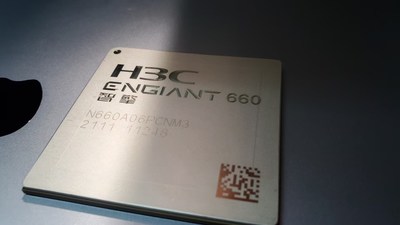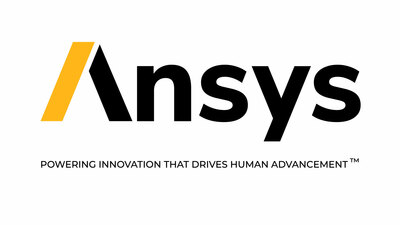H3C Semiconductor and Ansys Innovate Next-Generation Network Processor Chip for High-end Routing, 5G Backhaul, AI and Cybersecurity Applications
H3C Semiconductor has launched the ENGIANT 660, a high-performance network processor chip designed for routing, AI, 5G backhaul, and cybersecurity applications. The development utilized Ansys' advanced multiphysics simulation solutions, enhancing product efficiency and reducing costs. Key features include 56G Serdes and LPDDR5 interfaces, with significant improvements in design signoff and production speed, cutting analysis times by 10x. This collaboration aims to address complex challenges in thermal reliability and power integrity for large-scale chips.
- Successful launch of the ENGIANT 660 processor chip.
- Utilization of Ansys simulation solutions led to a 10x reduction in analysis times.
- Enhanced design efficiency and reduced development costs through advanced simulations.
- None.
PITTSBURGH, April 14, 2021 /PRNewswire/ --
/ Key Highlights
- H3C Semiconductor designers used Ansys' comprehensive multiphysics platform — including Ansys SIwave, Ansys HFSS, and Ansys RedHawk-SC — to engineer a state-of-the-art network processor chip featuring 56G Serdes and LPDDR5 interfaces
- Using Ansys solutions, H3C Semiconductor designers managed multifaceted design issues from chip design to signoff, co-simulating the chip and package to power advanced routing, 5G backhaul, artificial intelligence (AI) and cybersecurity applications
H3C Semiconductor leveraged Ansys (NASDAQ: ANSS) simulation solutions to launch ENGIANT 660, a highly sophisticated network processor chip that enables routing, AI, 5G backhaul and cybersecurity applications. H3C Semiconductor designers used Ansys' cutting-edge multiphysics simulation platform to enhance product signoff efficiency, spur product development and pass stringent testing requirements.
To innovate a large-scale complex network processor chip for advanced processes, reduce development costs and solve a myriad of complicated design issues, H3C Semiconductor designers employed a broad spectrum of multiphysics simulation solutions. Ansys solutions empowered designers to perform comprehensive analysis of power noise, signal integrity, thermal reliability and structural dependability from chip design to signoff. This ensured the highly reliable processor chip met demanding design specifications and accelerated the development of chip, package and system.
By integrating Ansys simulations into their workflow, H3C Semiconductor designers cut hardware costs and substantially sped production of next-gen chips for routing, AI, 5G backhaul and cybersecurity applications. Designers used Ansys® Redhawk-SC™ with its cloud-native, elastic compute Ansys® SeaScape™ database to validate full-chip power integrity and slash analysis times by 10x. Additionally, they harnessed Ansys® SIwave™ to analyze signal integrity, leveraged Ansys® HFSS™ to optimize 3D electromagnetic performance and used Ansys® Mechanical™ and Ansys® Icepak® to solve difficult thermal and structural reliability issues.
"As enterprise customers rapidly develop high-end core routers, 5G backhaul, SDN/NFV, AI, Firewall and Load Balancing applications around the world, Ansys' multiphysics simulation solutions for chip packaging systems address the thermal and structural reliability and power integrity challenges associated with large-scale chips," said David Dai, vice president of engineering operations at H3C Semiconductor. "Collaborating with Ansys proved instrumental to our design team, which heavily relied on simulations to create ENGIANT 660, the first network processor chip independently developed by H3C Semiconductor."
"Engineering new chips for exciting new routing, 5G, AI and cybersecurity applications creates complex power noise and electromagnetic, thermal and structural challenges that can only be overcome with simulation," said John Lee, vice president and general manager at Ansys. "Our continued collaboration with H3C Semiconductor will drive new designs with increased confidence and help ensure first-time design success across their organization."
/ About Ansys
If you've ever seen a rocket launch, flown on an airplane, driven a car, used a computer, touched a mobile device, crossed a bridge or put on wearable technology, chances are you've used a product where Ansys software played a critical role in its creation. Ansys is the global leader in engineering simulation. Through our strategy of Pervasive Engineering Simulation, we help the world's most innovative companies deliver radically better products to their customers. By offering the best and broadest portfolio of engineering simulation software, we help them solve the most complex design challenges and create products limited only by imagination. Founded in 1970, Ansys is headquartered south of Pittsburgh, Pennsylvania, U.S.A. Visit www.ansys.com for more information.
Ansys and any and all ANSYS, Inc. brand, product, service and feature names, logos and slogans are registered trademarks or trademarks of ANSYS, Inc. or its subsidiaries in the United States or other countries. All other brand, product, service and feature names or trademarks are the property of their respective owners.
ANSS–C
/ Contacts
Media | Mary Kate Joyce |
724.820.4368 | |
Investors | Kelsey DeBriyn |
724.820.3927 | |
![]() View original content to download multimedia:http://www.prnewswire.com/news-releases/h3c-semiconductor-and-ansys-innovate-next-generation-network-processor-chip-for-high-end-routing-5g-backhaul-ai-and-cybersecurity-applications-301268636.html
View original content to download multimedia:http://www.prnewswire.com/news-releases/h3c-semiconductor-and-ansys-innovate-next-generation-network-processor-chip-for-high-end-routing-5g-backhaul-ai-and-cybersecurity-applications-301268636.html
SOURCE Ansys
FAQ
What is the significance of H3C Semiconductor's ENGIANT 660?
How did Ansys contribute to the development of the ENGIANT 660?
What are the key features of the ENGIANT 660 chip?
When was the ENGIANT 660 launched?









